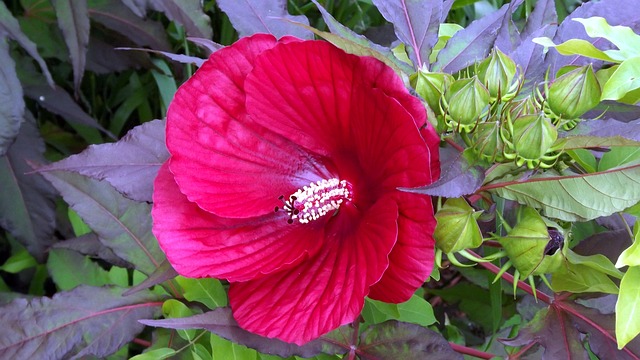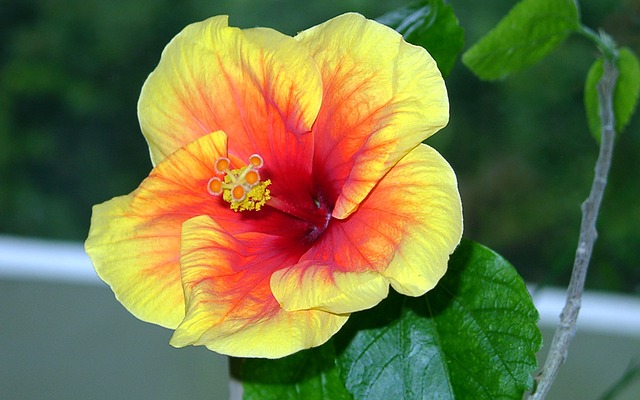White Flies on Hibiscus

Gardening Question from Jim:
Seems like every other year I get small infestations of white flies on my Hibiscus plants. Usually it’s only one, I’ll prune all the infected leaves off and spray with soapy water. My property has wasps, which I have heard, to be a good insect to kill off the White Fly,
Just not this year.
The reason the White Fly concerns me, is that within my garden I have tropical Ginger, Haliconia and Canna. I am so worried the little cotton ball bugs will spread and destroy because of their ferocious appetite for tender leaf plants. I have lovingly grown and cared for my tropicals for over twenty years and their blooms bring visions of the Islands every year and I would hate to lose them.
Would have any have additional organic answers to my dilemma?
I have watched your youtube videos and have enjoyed them very much. I hope to hear from you soon.

Answer from Pat:
Yes, I do have a suggestion: The first rule is that hibiscus needs full sun. If it is not growing in full sun it will always get giant white fly, which is what your plants have. (Green house white flies are different. These are little white flying insects that fly out in a cloud when you pass a plant such as for example, fuchsia or tomato. Giant white fly lay circles of eggs on the bottom of the leaves of tropical plants and then create a lot of messy white filaments. Once hibiscus gets giant white fly, then it will migrate to other tropical plants in your garden or your neighbor’s garden. The good news is that the Department of Agriculture and the California Extension has released beneficial insects to help control this pest.
So the first rule is make sure each plant you have is growing in appropriate light. Do not grow plants adapted to full sun in partial shade. Move them into full sun. Do not grow plants adapted to partial sun in full shade. A “shade plant” does not mean it likes full shade. Only a few plants grow in full shade. Most shade plants prefer partial shade, which can occur on the east or west of your house where plants get half of each day’s full sunlight. (West is more difficult since some plants, such as impatiens, wilt if given sun only in the afternoon.)
Secondly, attract birds to your garden. Install a fountain with running water. This will bring them and make it tall enough so that cats can’t kill them. Several birds love giant white fly.
Third: Wash off your plants that are suffering from giant white fly by using a strong spray of water. You can even scrub off the backs of leaves with a wash cloth to remove the white fly eggs. Use fatty acid soap if desired, or even Palmolive dishwashing soap will work.
Fourth: Purchase bags of Wormgold Worm Castings and place a layer of these worm castings about an inch thick over the roots of plants. This works particularly well with begonias growing in pots or tubs. Once having done this, you will find that in about two or three weeks that begonia growing in a tub will have no more giant white flies. They will have vanished.


The leaves of our hibiscus bush are covered with a white fuzzy growth. The ground below the bush is black. There are tiny flies buzzing around the leaves. Do you know what this is? I have photos, if there is some way to send them.
This sounds like giant white fly. To get rid of this pest, purchase 2 or 3 bags of earthworm castings (preferably Worm Gold brand), water the plant deeply, and clip off any leaves or branches touching the ground or any other plant. Then completely cover the ground under the hibiscus from the trunk to the ends of the branches with a layer of earthworm castings about an inch thick or even thicker. You can then water and care for the plant according to your usual schedule. If the hibiscus is growing in a tub the white flies will be totally gone in 2 weeks time. If the plant is in the ground it may take a week longer.
The reason this works is that earthworm castings contain chitinase, an enzyme that destroys chitin and chitin is the substance out of which the exoskeletons of insects are made.
I have 2 Hibiscus that I bring in every winter….Today I was looking at them, I noticed a couple of very sticky leaves and when I touched the plant a lot of little white flies flew out….I have sprayed them down with the hose and have applied a bunch of Bug B Gon…Insecticide soap…Will this look after them? I have them outside as it is getting warmer. I will leave them out tonight but will probably wrap them up in a towel so they don’t get too cold. I need some help please!! Look forward to hearing from you
Tanya
Yes insecticidal soap should get rid of white flies but the larvae live in the soil and so they can come back. Foolproof way to get rid of them: Cover the soil in the pot
with an inch of worm castings. Irrigate as usual. It takes 2 or 3 weeks and the white flies will be totally gone. If this ever happens again in future. Repeat the treatment.
Be sure to fertilize the hibiscus with balance fertilizer all summer long beginning in March. (Earthworm castings are not a fertilizer.) Also cut back the branches progressively to control size and keep plant compact. Once a month beginning in March or when your plant begins growing, cut back 2 opposite branches by 1/3 of their length. Continue doing this once a month all spring and summer long until September/ This is called “Progressive Pruning.” The hibiscus will then be renewed from within the plant throughout the year instead of growing longer and longer branches and popping a flower on the end of each branch.